Towards the end of 2020, as most cultural institutions were temporarily closing down worldwide for the second time in a year, SUPRAINFINIT Gallery was announcing the opening of the group exhibition Of Refrains and Liminal Spaces in Bucharest. Making the best of the invitation to display their works again in an institutional environment, after months of limitations and cancelled events, several artists from the gallery’s own portfolio, as well as other guests, local and international, found their refuge on 22 Mantuleasa Street – Alina Feneș Crasovschi, Apparatus 22, Candice Lin, Jala Wahid, Jimmy Robert, Justin Mortimer, Marius Bercea, Peleș Empire, Simion Cernica, Umar Rashid (Frohawk Two Feathers) and Vlad Nancă.
Initially planned in February 2020 by the gallery’s artistic director and curator, Cristina Vasilescu, the exhibition revolves around the concept of liminality, a term borrowed from anthropology initially describing the transition rituals developed within human communities in relation to events such as birth and death. A liminal space is confused and transitory: it is a real or an imaginary boundary. It can be personal or collective; in Of Refrains and Liminal Spaces, it makes reference to our current chaotic pandemic situation, to transnational or transcommunitarian political conflicts, to renegotiating our relationship with ‘nature’, to forgotten colonial histories, or simply to delicate times in personal histories (not any less political than the others).
In what follows, we are proposing two non-mutually-exclusive trajectories through the gallery space and two subsequent ways of seeing the exhibition: we intersect in front of SUPRAINFINIT’s outside window, showcasing Marius Bercea’s work Formula for the big picture (2020). The first incursion begins from the global, transnational, and collective level, descending towards the individual and the personal via the second incursion.
Traversing discursive boundaries
I resonated considerably with the socio-political messages of the exhibition, which maintained my curiosity throughout the visit. Of refrains and liminal spaces manages to place diverse geographical, historical, and political context into dialogue without appealing to uncritical cosmopolitan clichés. My trajectory begins (approximately) in the center of the exhibition space with the three jesmonite pieces by London-based Kurdish artist Jala Wahid.
Asymmetrically hung by the back wall of the main gallery room, Nothing Left To Proceed You II (2020), Lying in Your Stream, Breathless Epiphany (2020) and My Heart Inflamed, Burns wild, Beats fast, This love will last (2020) construct a chromatically vibrant landscape using kurdish symbols recontextualized in a diasporic spin-off. Culture and ritual are regarded as edifying for the construction of national identity – of an ‘imagined community’[1], to used political scientist Benedict Anderson’s term – for a stateless community. The sun[2], which also figures on the Kurdish flag, represents the cyclicity of life through birth, celebration, death, and mourning. Here, you can only see one of its halves. Above the sun sits the Nazar amulet, with long eyelids and a ministering female gaze.
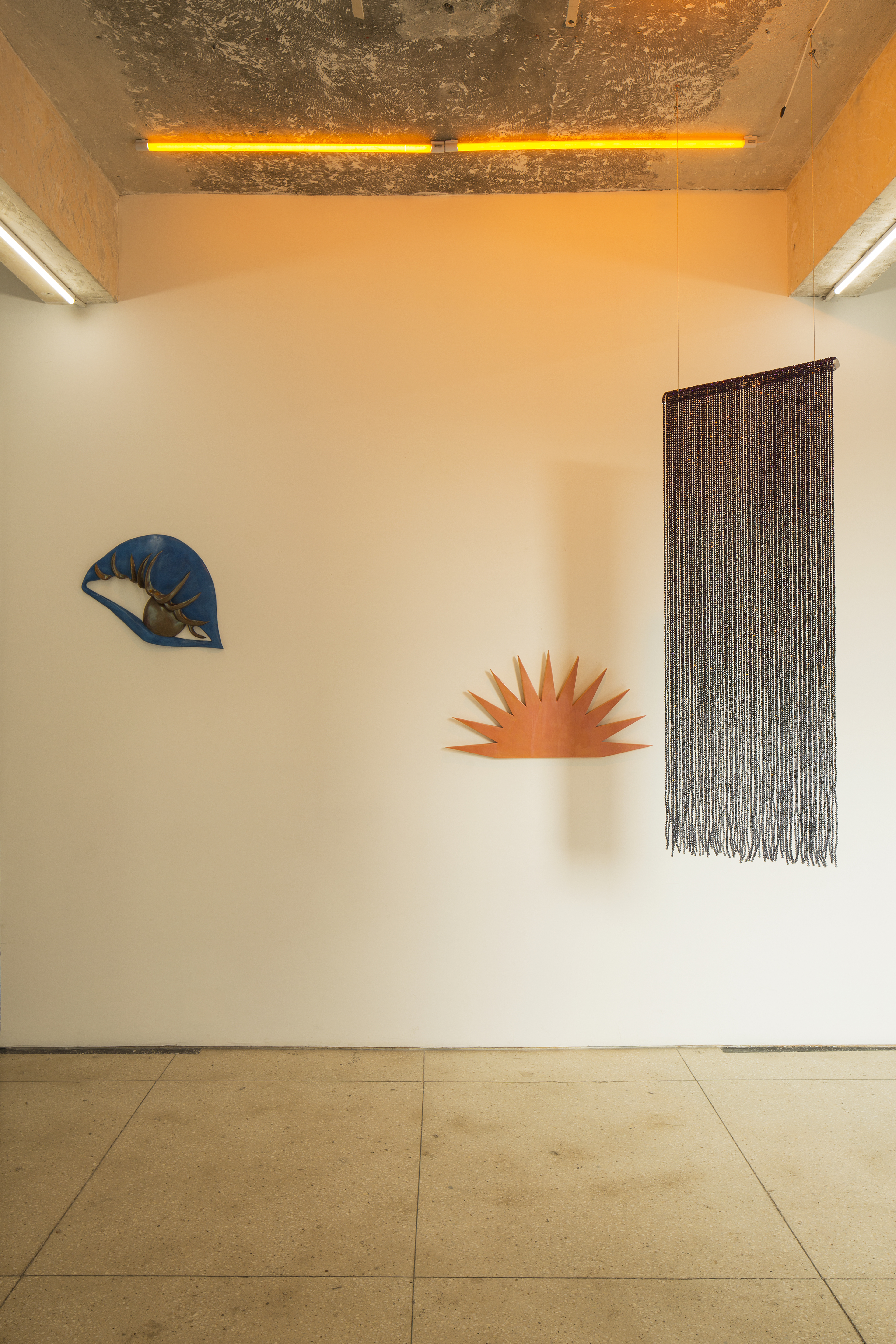
Jala Wahid – works 2020 / Courtesy of the artist and Sophie Tappeiner Gallery, Vienna. Photo by: Sebastian Apostol / Polysemic studio
If you turn around by 90 degrees to the right, you’ll see another series on ‘national’ rituals. Only this time around, they constitute the colonial Dutch mythology. Dark, chaotic, and satirical, the comic-like painting of artist Umar Rahid (a.k.a. Frohawk Two Feathers), Sub Specie Aeternitatis. A philosophy of Dutch colonialism (2020) tells a non-linear and rhizomatic story of seventeenth century imperialism. Historical figures such as Spinoza and Erasmus of Rotterdam are accompanied by contemporary pop culture references.
On the left and right of Sub Specie Aeternitatis, the (anti)ecological, medical, racialised, and gendered dimensions of colonial discourses are taken up by the interdisciplinary and profoundly theoretical practice of artist Candice Lin. The two graphite and ink drawings are part of a larger artistic project of Lin’s, conducted during a residency at the socially-engaged 18th Street Art Centre in LA. The two works at SUPRAINFINIT are Sycorax’s Collection (Herbarium) (2011) and Principles of Wastage in Wet Nursing (2009). The name Sycorax comes from the witch in the Tempest, described by Shakespeare as a “savage and deformed slave”. Inspired by Silvia Federici’s feminist critique, Candice Lin investigates the representations of women of color (marginalized by Western medical knowledge and science) as monstrous in the white and colonial imagery. Appropriating the botanist’s style to critique it, Lin wants to remind us that plant knowledge had a very important historical role in anti-colonial, anti-slavery, and anti-mysoginistic struggles.
Across the road from Lin’s second work lies the print aphrodite 1 by German artist duo Peleș Empire. Starting from the Cleopatra tapestry at Peleș Castle, Romania, the two artists continue our theme of female representation, superimposing the image of the Egyptian queen with that of goddess Aphrodite. Peleș Empire were fascinated with the castle’s collection: not by its richness, but by its numerous copies; and copies of copies. While colonial states and empires, like Umar Rashid’s Dutch empire, ‘benefited’ directly from archeological discoveries, as well as from stealing art objects from other continents, the lack of original objects demonstrates the peripheral nature of Eastern European geographies and, at the same time, the idealization and fetishization of the colonial center.
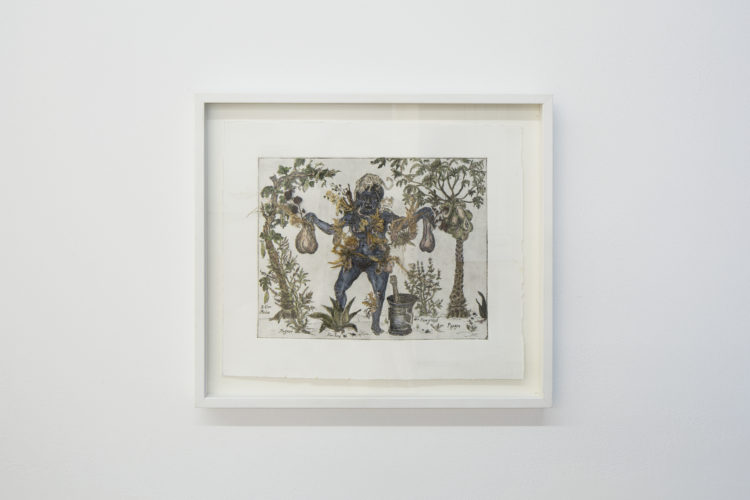
Candice Lin – Sycorax’s Collection (Herbarium), 2011 / Courtesy of the artist and Francois Ghebaly, Los Angeles. Photo by: Sebastian Apostol / Polysemic studio
We meet in front of the gallery, where the window showcase awaits us with two pieces by artist Marius Bercea that were specifically commissioned for the exhibition. Two lightboxes with decoupages from photographs taken in California, placed over the figurative painting mounted on wood. Formula for the big picture (2020) functions like an anti-ad, in that it doesn’t help the visitors set out their expectations about the inside content of the exhibition. The piece reminds us of the history of 22 Mântuleasa Street. Before SUPRAINFINIT, it operated as the neighborhood’s grocery store. Cristina tells us that she started using the showcase five or six exhibitions ago as a critique of the tiny and cramped neoliberal gallery spaces in London, where every square meter is carefully monetized.
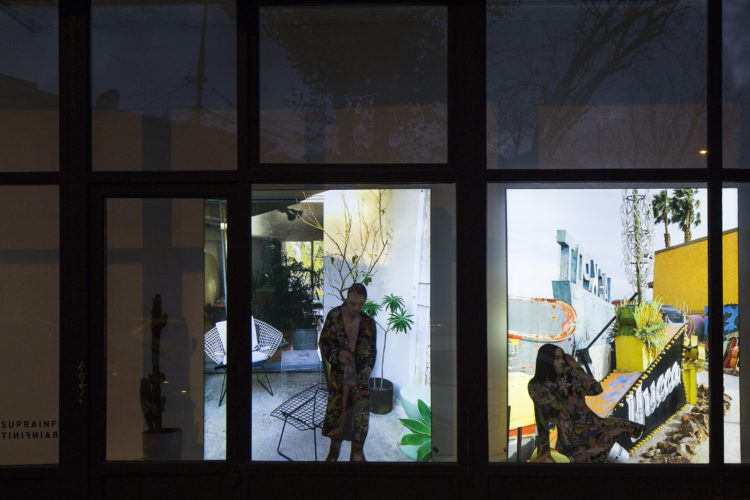
Marius Bercea – Formula for the big picture (detail), 2020, two light boxes / Courtesy of the artist and Suprainfinit Gallery, Bucharest. Photo by: Sebastian Apostol / Polysemic studio
The installations are accompanied by a live cactus, contrasting the still life of artist Justin Mortimer’s Hoax 26 (2017) inside. Uprooted nature, left to die in creative/ commercial spaces because of the pandemic, has as of late gained prominence in the art world, such as on the May – June 2020 Artforum cover. ‘Liminal space’ also gains terrain for LA-based Romanian artist Simion Cernica. In Untitled (B04 Criminal Banality), the vandalizing of the canvas coincides with the rediscovery of painting as a technique, in a period dominated by personal changes.
Escapism 1:1
In this second incursion that I propose, I was interested in the connections that can be traced between different gestures of representing the human, as well as the ways in which these links re-problematize the curatorial dimension in Of refrains and liminal spaces.
At the entrance of the gallery space, myself and a silhouette extracted from 20th-century modernist architectural plans, brought to life by a 1:1 scale-up, reciprocally scan each other; yet we don’t interact. Recontextualized in the gallery’s climate, converted in 3D, the iron-welded avatar keeps the same ratio of the initial one-line minimal gesture of representation from the original drawing. A body lacking physiological features, hair, gender, race, senses, emotions, and opinions. Neither old nor young. Haunting the corner of the room with white walls.
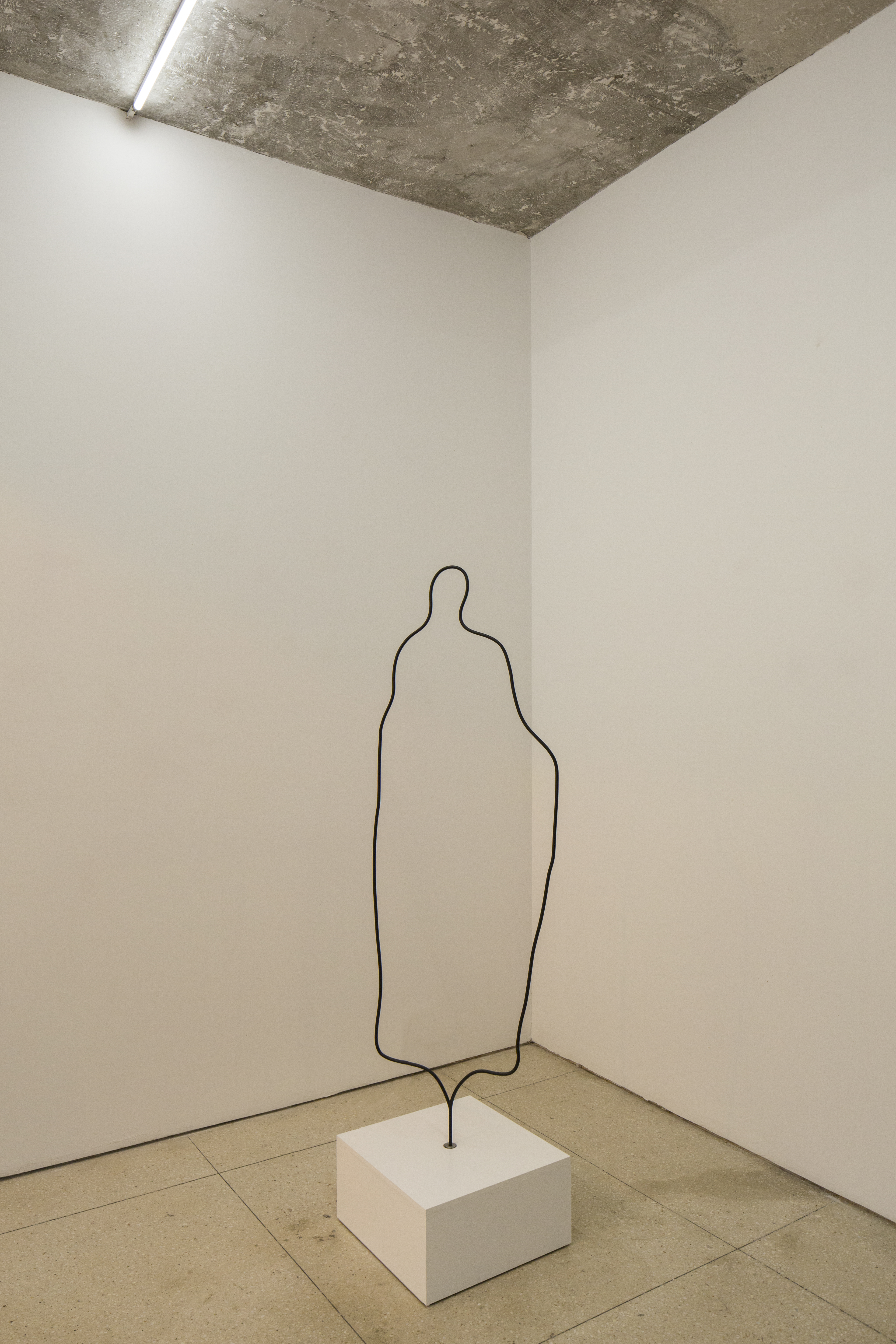
Vlad Nanca – Rotating Silhouette, 2018 / Courtesy of the artist and Suprainfinit Gallery, Bucharest. Photo by: Sebastian Apostol / Polysemic studio
Similar observations more or less structure the book chapter Designing a Ghost on the absent presence of protohuman/posthuman characters in photo-realistic images generated through architectural rendering. Designing a Ghost is part of architect-theoreticians Beatriz Colomina and Mark Wigley’s book, Are we human? Notes on an archaeology of design (2016). Overwhelmed by their own modernity, the human remains suspended in a lightheaded state produced by continuous rotations, giving an impression of a hostile environment. Rotating Silhouette (2020) is Bucharest-based artist Vlad Nancă’s work. During SUPRAINFINIT Gallery’s first participation at the ARCOMadrid 2020 art fair, the pieces attracted the jury’s attention. Nancă’s solo exhibition was awarded the best booth prize for emerging galleries.
From where I am standing, I detect other (de-humanized) human presences in the space and I head diagonally towards the massive installation at the window. This time, I myself rotate around the three-legged headless bodies. A recent image of David Lynch sitting in a chair comes back immediately to my mind. He is offering the daily weather report for Friday, 28 August 2020: “What a great time to be alive if you love the theatre of the absurd”[3]. Half-hidden in a room that is supposed to resemble a secret bunker (bathed in natural light), David Lynch reinstated his early-2000s amateur meteorologist calling in the same ever-sunny LA office.
I come back to the ”quintessential thoughts” of the (failed) Romanian futurologist[4] group, because it is worth being analyzed in more depth. 2020 was a year of introspection and of many escapes from the every day for the transdisciplinary art collective Apparatus 22. This was manifested through their return to SUPRAINFINIT, an affective space, a utopian universe imagined and built five years ago by the group’s current members, Maria Farcaș, Erika and Dragoș Olea.
The installation TRINITY, TRIANGLE, THREESOME/ no.2 (2020) continues an older work and, while it could leave the impression of parallel approaches, things are not that polarized. From my angle, the tripod silhouettes function like prostheses that hold the content (flesh), camouflaged under new layers of recycled natural leather jackets. Apparatus 22 explores radical representations of the human body, which is constrained by the (absurd) pretensions of our times. The installation projects me to a common reality that brings us closer to a future that not long ago could be only speculated.
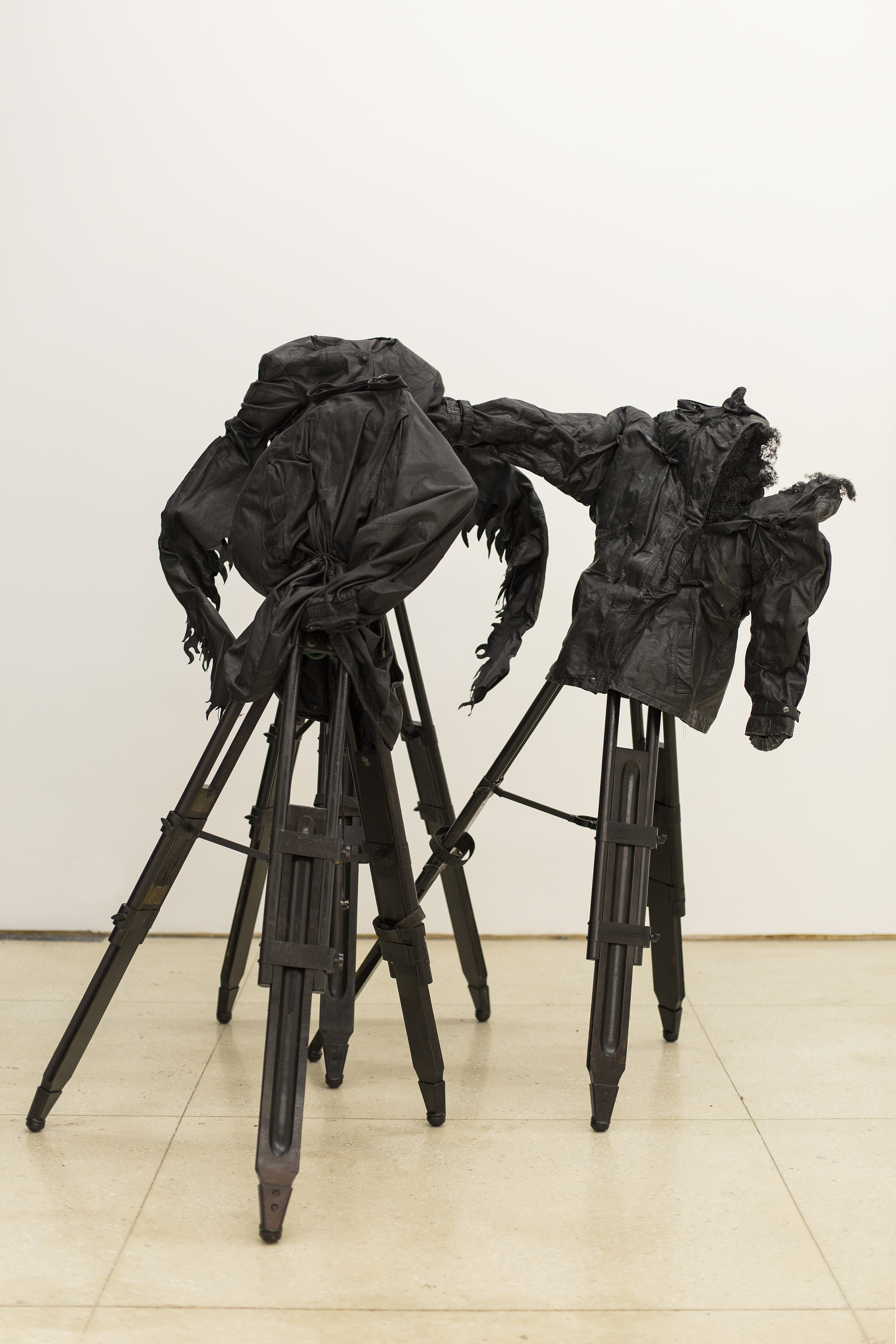
Apparatus 22 – TRINITY, TRIANGLE, THREESOME/ no.2, Installation / Courtesy of the artist and Suprainfinit Gallery, Bucharest. Photo by: Sebastian Apostol / Polysemic studio
I navigate for a couple of moments between past and present. Alina Feneș Crasovchi’s Sunset (2020), exhibited on the opposite wall, hooks me. Her work has preoccupied me constantly ever since I saw the exhibition. The artist lives and works in Petru Vodă village. I am struck by the graph paper and by the mutual coexistence between the depersonalized silhouette, scaled up to human size, and its surroundings. I stop in front of the dehumanized character suspended in the atemporal. I study the body’s proportions. It seems to me that, even in isolation, it is allowed to communicate with a wider context. Provincialization does not mean irrelevance from an artistic point of view. On the contrary – this painting manifests an acute questioning. The human presence does not solicit me, so I decided to stay with the piece for a little while longer. The mountainous landscape works like bedroom wall tapestry for someone that now lives their life in big cities. It calms me down and makes me contemplative. I clutch my arms to the imaginary skewed line that severs the image and I let the whole weight of my body hang. I decide to distance myself from all that I have lived through in the past months. I want to see where I’m at, what my boundaries are.
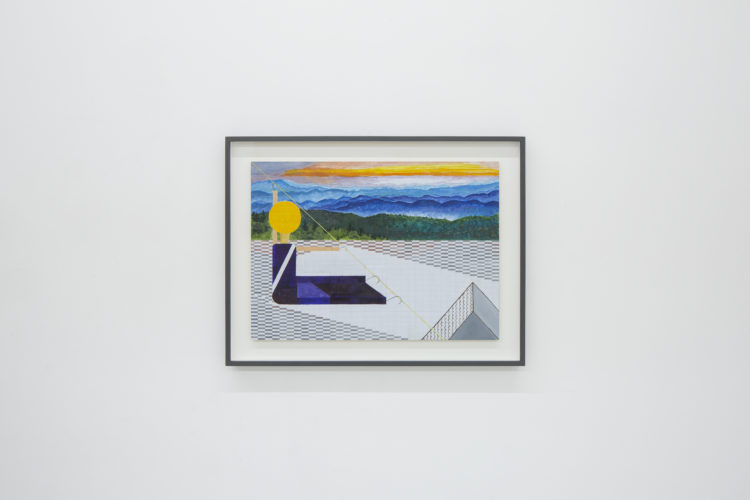
Alina Fenes Crasovschi – Apusul soarelui, 2020 / Courtesy of the artist and Suprainfinit Gallery, Bucharest. Photo by: Sebastian Apostol / Polysemic studio
Following up on the observations above, reflecting upon 2020 as a lost year (for many), I am wondering to what extent the uncommitted presence of these fictional characters points towards the sentiment of crisis which lingers in the personal and the collective in the current epidemiological context, where we are required to give new meanings to private time and private space.
From the back room, artist Jimmy Robert is talking to me from afar about the invisibility of the body. With its simple movements, the video documentation of his performance, A clean line that starts from the shoulder (2016), prolongs the reflection around the body representations in art. In the beginning of the recording, I observe a reference to Untitled (Agon) (2015), a collage on display in the main room. I approach the collage to decipher the stratified narrative. The plasticity of the paper attracts me, as does the skewness of the paper. The work’s title evokes the first New York ballet act which starred an African-American male dancer back in the 60s. The images are superposed with those of Congolese men, drawn by Idel Ianchelevici, who emigrated to Brussels in 1928.
The exhibition Of refrains and liminal spaces can be seen until the 20th of February 2021. SUPRAINFINIT’s schedule can be consulted online at suprainfinit.com in a triptych format: past, present, future. Until further notice, the future remains a blank space where one is left to wonder whether something else will follow.
[1] In: Anderson, B. R. O. 1. (1991). Imagined communities: Reflections on the origin and spread of nationalism (Rev. and extended ed.). Verso Books. London/New York.
[2] You can find the sun motif in other works of Jala Wahid. See Newroz (2019) exhibition. Review: Hastings, T. (2019). ‘Newroz’: Artist Jala Wahid’s Poetic Celebration of Kurdish New Year. Frieze Magazine.
[3] “What a great time to be alive if you love the theatre of the absurd”, David Lynch in Weather Report 8/28/2020.
[4] Apparatus 22 see themselves as a transdisciplinary collective of dreamers, researchers, poets and (failed) futurologists.
POSTED BY
Maria Persu & Tatiana Moise
Maria Persu (b. 2000) is a student and freelance art & culture journalist (Scena9, SAVAGE Journal). She studies philosophy and political science at University College London. Her main interests li...


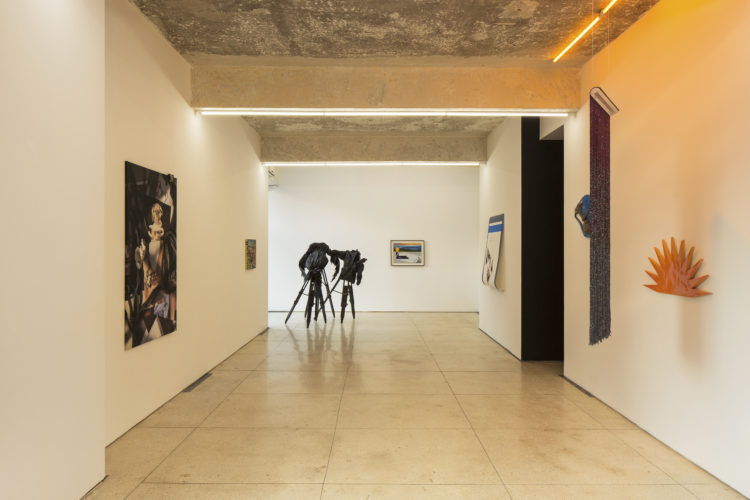
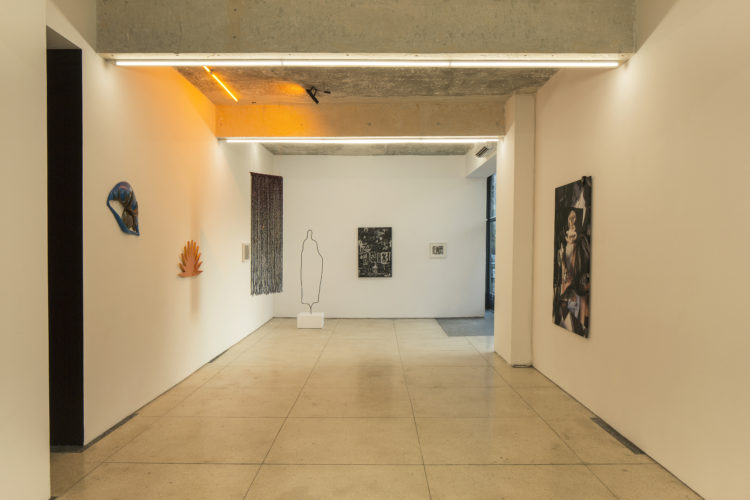
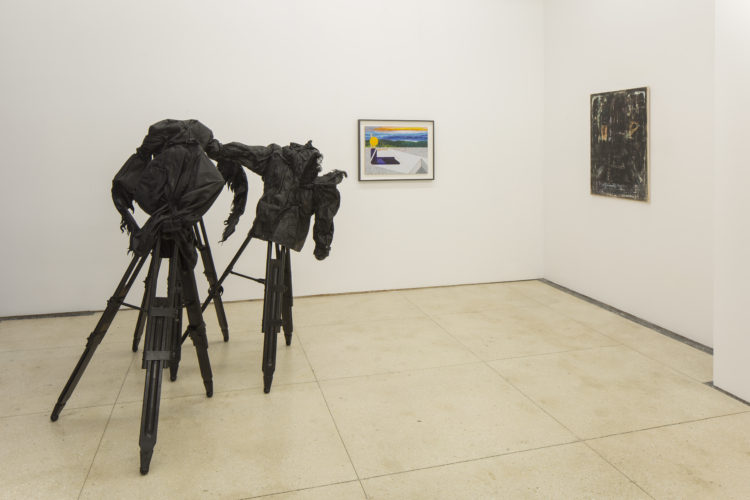
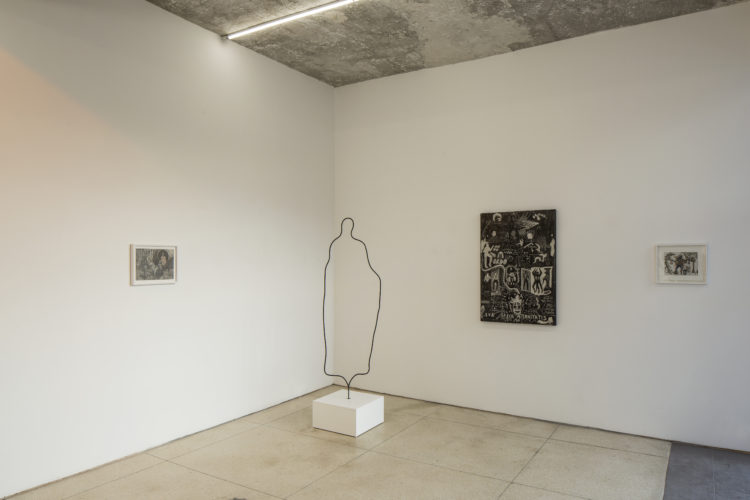
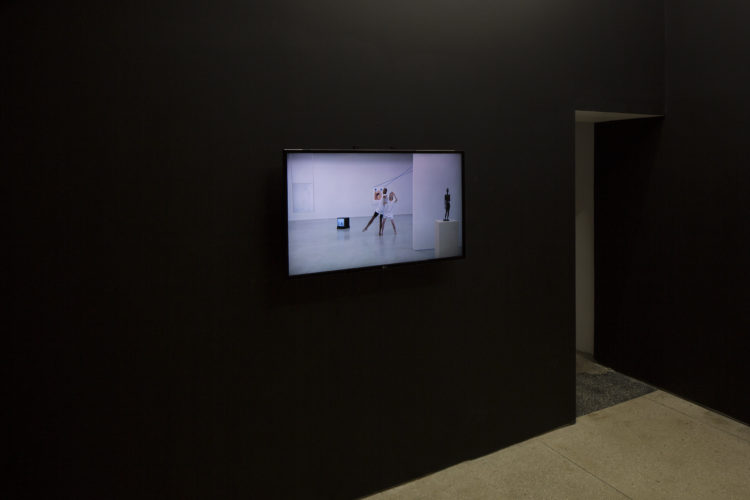
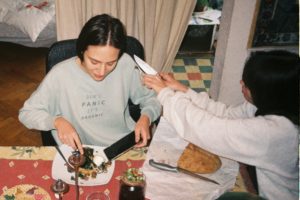
Comments are closed here.